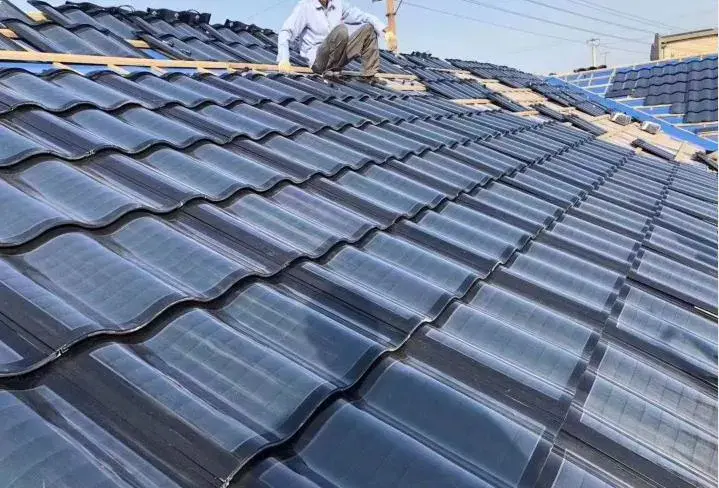
As the demand for sustainable energy solutions grows, the U.S. government is ramping up incentives and rebates for solar roof tiles. By 2025, homeowners can expect a range of financial benefits aimed at reducing installation costs, promoting clean energy adoption, and enhancing energy efficiency. These initiatives aim to make solar technology more accessible, fostering a greener future for all.
As the adoption of renewable energy sources continues to rise, **solar roof tiles** have emerged as a popular choice for homeowners looking to reduce their carbon footprint while saving on energy costs. The U.S. government has recognized this trend and is offering various **incentives and rebates** to encourage the installation of solar technologies, including solar roof tiles. By 2025, these initiatives are expected to expand significantly, making solar energy more accessible and affordable for a larger segment of the population.
Government incentives play a crucial role in promoting the use of **solar energy**. These incentives can come in various forms, including tax credits, grants, and rebates. In the United States, the **Federal Investment Tax Credit (ITC)** is one of the most significant incentives available for solar installations. Homeowners can deduct a percentage of their solar installation costs from their federal taxes. As of 2023, this credit stands at 30%, but it is set to gradually decrease to 26% in 2024 and 22% in 2025. This timeline makes it essential for homeowners to consider installing solar roof tiles sooner rather than later to take full advantage of the ITC.
In addition to federal incentives, individual states also offer their own **rebates and incentives** for solar roof tiles. These programs can vary significantly depending on the state, so homeowners should research what is available in their area. Some states provide upfront rebates that reduce the installation cost, while others may offer performance-based incentives that pay homeowners for the energy produced by their solar systems.
Here are some examples of state-level incentives for solar roof tiles:
| State | Incentive Type | Details |
|---|---|---|
| California | Incentive Program | Net Energy Metering (NEM) allows homeowners to receive credits for the energy their solar systems produce. |
| Florida | Sales Tax Exemption | Exemption from sales tax on solar equipment purchases. |
| New York | State Tax Credit | Up to 25% tax credit for solar installations. |
| Texas | Property Tax Exemption | Solar installations increase home value, but homeowners won't pay property taxes on that increase. |
Many local governments and utility companies also offer **incentives for solar roof tiles**. These can include additional rebates, special financing options, or even performance-based incentives. Some utilities have programs that allow homeowners to sell excess energy back to the grid, creating a potential revenue stream. Checking with local utility providers can help homeowners discover all available options in their area.
Moreover, community solar programs are becoming increasingly popular, allowing homeowners to invest in solar energy without having to install panels on their property. This is an excellent option for those who cannot install solar roof tiles due to roof orientation or other factors.
Financing is another critical aspect of making solar roof tiles more accessible to homeowners. Various financing options can help alleviate the upfront costs associated with installation. These include solar loans, leases, and power purchase agreements (PPAs). With these financing mechanisms, homeowners can install solar roof tiles with little to no upfront payment, making it easier to benefit from government incentives and rebates.
As we look ahead to 2025, the landscape for **solar roof tiles** and government incentives is expected to evolve. Several factors may influence this evolution, including advancements in solar technology, changes in government policy, and the increasing urgency of addressing climate change. The Solar Energy Industries Association (SEIA) projects that the residential solar market will continue to grow, driven by both federal and state incentives.
Moreover, as more states adopt renewable energy targets, homeowners can expect to see a wider array of incentives and rebate programs. The push for sustainability and green energy is gaining momentum, making it likely that more local governments will introduce their own initiatives to support solar energy adoption.
In summary, the U.S. government is actively supporting the adoption of solar roof tiles through various incentives and rebates, making this sustainable energy option more financially feasible for homeowners. With federal tax credits, state-level incentives, local programs, and diverse financing options, there has never been a better time to invest in solar technology. As we approach 2025, homeowners should stay informed about these incentives and consider taking advantage of them to enjoy the benefits of renewable energy while contributing to a greener future.

Cost and Financial Benefits of Solar Roof Tiles in 2025
The Future of Solar Roof Tiles in the USA: Trends and Innovations for 2025
Top Benefits of Installing Solar Roof Tiles in Your Home by 2025
Comparing Solar Roof Tiles vs. Traditional Solar Panels: What to Expect in 2025
How Solar Roof Tiles Can Increase Your Home's Value in 2025
The Best Solar Roof Tile Brands to Watch in the USA for 2025
A Comprehensive Guide to Choosing the Right Solar Roof Tiles for Your Home in 2025

The Environmental Impact of Solar Roof Tiles: What We Can Expect in 2025